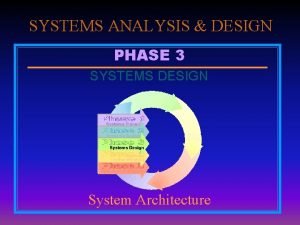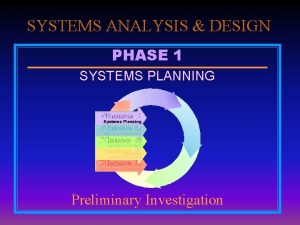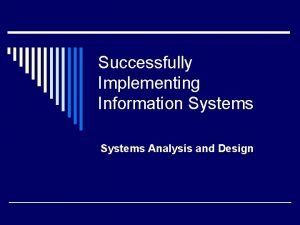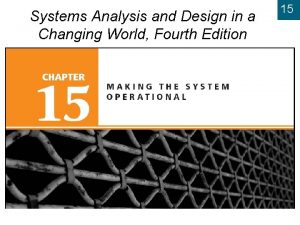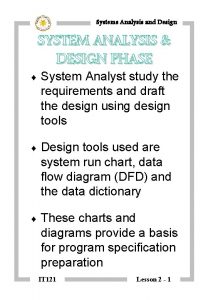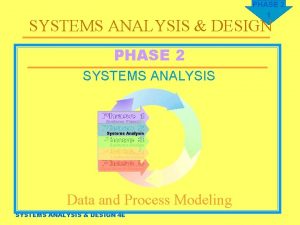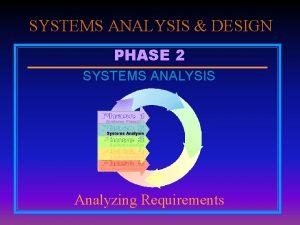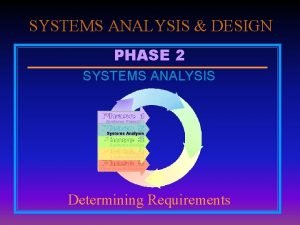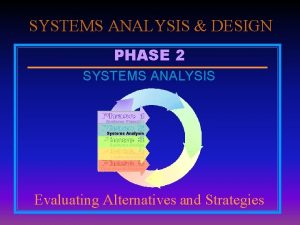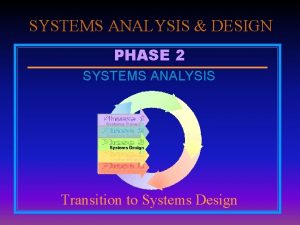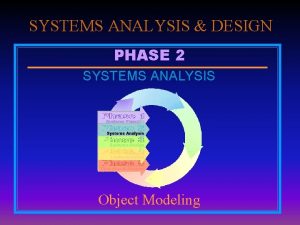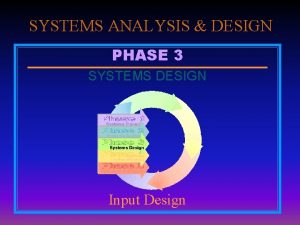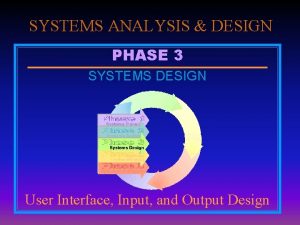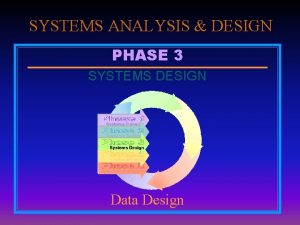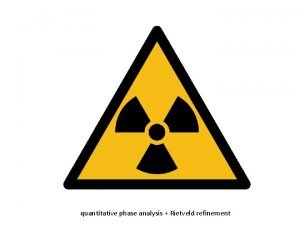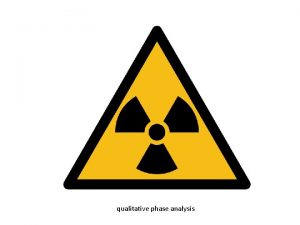SYSTEMS ANALYSIS DESIGN PHASE 1 SYSTEMS PLANNING and








































- Slides: 40

SYSTEMS ANALYSIS & DESIGN PHASE 1 SYSTEMS PLANNING and Preliminary Investigation

Systems Planning Objectives Learn how projects get started Learn how projects are evaluated initially

Preliminary Investigation Objectives Describe the strategic planning process, and why it is important to IS managers Explain the purpose of a mission statement Explain why and how systems projects are initiated Explain how systems projects are evaluated

Preliminary Investigation Objectives List the objectives of the preliminary investigation Describe what activities occur during the preliminary investigation Carry out fact-finding procedures to evaluate the systems request Describe what takes place at the completion of the preliminary investigation

Introduction Systems planning tasks Examine the systems request Conduct a preliminary investigation Determine whether further development is warranted

Introduction Systems planning topics Why and how systems projects originate Objectives and scope of the preliminary investigation Fact-finding tasks Activities that complete the systems planning phase

Strategic Planning Process Strategic planning is the process of identifying long-term organizational goals, strategies, and resources Strategic Planning Overview SWOT analysis

Strategic Planning Process v. From Strategic Plans to Business Results Mission statement Stakeholders Goals Objectives 8

Strategic Planning Process Stakeholders are people affected by the company’s performance Stakeholders include: Customers Employees Suppliers Stockholders Members of the community

Strategic Planning Process The impact of technology Rapid expansion of information technology is creating entirely new industries, such as E-commerce Online stock trading Change will be constant Global competition Rapidly changing markets Explosive growth of information technology

Origination Systems Projects Reasons For System Projects -A goal is an end that the organization is striving to attain. -An objective is a task that will help achieve a goal. -A system request is a formal request for the services of information system department. Starting point is a systems request

The reasons for systems requests by the type of improvement required Improved service Better performance More information Support for New Products and Services Stronger controls Reduced cost

Improved service Reduced cost Better performance Systems Request Stronger controls Support for New Products and Services More information

• Sources of systems projects Who initiates systems projects? We can trace the origination of systems projects to the five sources. - End user requests - Top-management directives - Existing systems - Information systems department - External forces

Strategic Plan Technology Top Managers Technology Suppliers User requests Customers Information Technology Department Existing Systems and Data Competitors Government The Economy Internal and external factors that affect IT systems projects.

• Request form and – Streamlines the process – Ensures consistency – Must be easy to understand use – Must include clear instructions procedure

Evaluation of system requests • Responsibility for evaluating systems requests – A group of key managers and users • Systems review committee • Steering committee • Computer resources committee • Computer policy committee – A single individual • Typical in smaller companies • Must consult with users & managers

Evaluation of projects Systems review committee tasks : • Evaluate requests • Set priorities • Assess feasibility

Overview of feasibility A systems requests has feasibility if the request can be successfully implemented. When you analyze feasibility, you must consider three separate types: - Technical feasibility - Operational feasibility - Economic feasibility

– Technical feasibility • Does the organization have resources to develop/purchase and operate the system? – Technical feasibility depends on: • Technical expertise within the organization • Availability of necessary equipment • Hardware and software reliability • Adequate performance that will meet specifications • Capacity for future needs/projected growth

– Operational feasibility • Is the system a practical and effective approach? – Operational feasibility depends on: • Management and user support • User involvement in planning • Impact on performance, customers, and company image • Reasonable schedules

– Economic feasibility • Do the projected benefits outweigh the estimated costs of development, installation, and operation? – Economic feasibility depends on: • Costs — one time and continuing costs • Benefits — tangible and intangible benefits • Timing of various costs and benefits • Cost of not developing the system

• Determining feasibility – First step is a determination of feasibility – Goal is to identify nonfeasible projects as soon as possible – Feasibility can change over time • Nonfeasible projects can be resubmitted • Initially feasible projects can be rejected later

Criteria used to evaluate systems requests • Reduce costs • Increase revenue • Produce more information or better results • Serve customers and the organization better • Reasonable time frame and lasting results • Resources available • Necessary or discretionary) รอบคอบระมดระวง ( • Tangible or intangible factors

Preliminary investigation objectives Purpose To decide whether to continue the project Objectives for Preliminary investigation 1. 2. 3. 4. 5. Understand the problem Define the project scope and constraints Identify the benefits Estimate the costs Report to management

Understand the problem Identify the true nature of the problem and the reason for the systems request Stated problem may not be the real problem Clear statement defines the investigation scope

Define the project scope and constraints Project scope Define the range or extent of the project Set project boundaries Constraints Identify conditions, restrictions)การควบคม ), or requirements àPresent vs. future àInternal vs. external àMandatory vs. desirable


Identify the benefits Tangible benefits Can be stated in dollars Based on increased revenue or reduced cost Intangible benefits Difficult to measure in dollars Can involve job satisfaction or company image

Estimate the time and costs Determine what information is needed Identify the sources of information Decide whether to use interviews, if so how many, and what time needed Decide whether to use surveys, if so who to complete it, and what time needed Estimate the cost of gathering, analyzing, and reporting the information to management

Report to management Final task in the preliminary investigation Key elements Evaluation of systems request Estimate of costs and benefits Recommendations

Planning the Preliminary Investigation During a preliminary investigation, a systems analyst typically follows a series of steps

Understandthe theproblemororopportunity. Define the project scope and constraints. Perform fact-finding. - Analyze organization charts. - Conduct Interviews. - Review documentation. - Observe operations. - Conduct a user survey. Analyze project usability, cost, benefit, and schedule data. Evaluate feasibility - Operational - Technical - Economic - Schedule Present results and recommendations to Management. Six steps in a preliminary investigation.

• Obtain authorization to proceed – Projects can create concern or opposition – Need clear authorization from management – Good communication is important • Initial meeting with managers and users • Explain the project • Describe your responsibilities • Invite questions

• Identify the necessary information – Review the preliminary investigation objectives – List all information needed for these objectives – Prepare a schedule of activities for this phase

• Perform fact-finding to gather the required information – Analyze organization charts – Conduct interviews – Review current documentation – Observe current operations to obtain information – Conduct a brief survey of people who use the system

Organization charts

• Analyze the information – Identify alternatives • Include costs and benefits • Recommend an action – Possible actions • Take no further action • Apply some other solution • Proceed to systems implementation phase • Proceed to next SDLC phase — systems analysis

Preliminary investigation completion • Present your results and recommendations to management - Typical report sections Ø Introduction Ø Systems request summary Ø Findings Ø Recommendations Ø Time and Cost estimates Ø Expected Benefits Ø Appendix • Oral presentation also might be required

 Planning phase for network security design
Planning phase for network security design Mobile phase and stationary phase
Mobile phase and stationary phase Mobile phase and stationary phase
Mobile phase and stationary phase Which detector used in hplc
Which detector used in hplc This is the final task in phase 3: systems design.
This is the final task in phase 3: systems design. This is the final task in phase 3: systems design
This is the final task in phase 3: systems design This is the final task in phase 3: systems design.
This is the final task in phase 3: systems design. This is the final task in phase 3 systems design
This is the final task in phase 3 systems design Kendall kendall
Kendall kendall Disaster recovery planning in system analysis and design
Disaster recovery planning in system analysis and design Normal phase vs reverse phase chromatography
Normal phase vs reverse phase chromatography Hplc reverse phase vs normal phase
Hplc reverse phase vs normal phase Normal phase vs reverse phase chromatography
Normal phase vs reverse phase chromatography Power formula three phase
Power formula three phase In a ∆-connected source feeding a y-connected load
In a ∆-connected source feeding a y-connected load Csce 441
Csce 441 Design input and output
Design input and output Systems analysis and design in an age of options pdf
Systems analysis and design in an age of options pdf Gantt chart system analysis and design
Gantt chart system analysis and design Systems analysis and design in a changing world
Systems analysis and design in a changing world System analysis and design in a changing world
System analysis and design in a changing world Systems analysis and design dennis
Systems analysis and design dennis Introduction of system analysis and design
Introduction of system analysis and design Ssadm model
Ssadm model Case tools are limited to systems analysis.
Case tools are limited to systems analysis. Modern systems analysis and design
Modern systems analysis and design Kendall & kendall systems analysis and design
Kendall & kendall systems analysis and design System analysis and design dennis
System analysis and design dennis Systems analysis and design alan dennis
Systems analysis and design alan dennis Systems analysis and design alan dennis
Systems analysis and design alan dennis Systems analysis and design alan dennis
Systems analysis and design alan dennis Systems analysis and design alan dennis
Systems analysis and design alan dennis Systems analysis and design alan dennis
Systems analysis and design alan dennis Systems analysis and design alan dennis
Systems analysis and design alan dennis Ssadm diagram
Ssadm diagram Radar range equation snr
Radar range equation snr Object-oriented systems analysis and design using uml
Object-oriented systems analysis and design using uml A modern approach to systems analysis and design
A modern approach to systems analysis and design Systems analysis and design kendall
Systems analysis and design kendall System analysis and design in a changing world
System analysis and design in a changing world Systems analysis and design in a changing world
Systems analysis and design in a changing world




